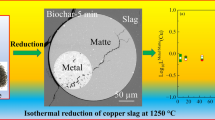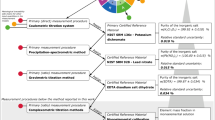Abstract
The object of the present study was to development of safe, reliable fast, and efficient methodologies for the direct determination of Al, Pb, Cu, and Cd in non-digested beer samples of widely consumed brand name beers sold in Brazil, using graphite furnace absorption spectrometry (GF AAS). Pyrolysis and atomization temperature curves of selected chemical modifiers (iridium, rhodium, ruthenium, zirconium, and non-modifier use) were used to stabilize each metal and sensitivity in a beer sample was diluted to 1:1 with 0.2 % v/v nitric acid after degasification. The best modifier for aluminum was permanent zirconium, with a characteristic mass of 4.2 pg (recommended is 10 pg), demonstrating a symmetrical peak with a corrected background using a deuterium arc lamp. For cadmium and copper, the best modifier was permanent ruthenium with characteristic masses of 0.3 and 7 pg (recommended are 0.35 and 4 pg, respectively, for Cd and Cu), respectively. The best condition for lead was using a non-modifier, with a characteristic mass of 6.9 pg (recommended is 10 pg). The limits of detection and mean recoveries, done over three consecutive days for aluminum, copper, lead, and cadmium, were 1.9, 2.9, 0.8, and 0.6 pg and 105, 104, 101, and 102 %, respectively. From the observed results, we may conclude that some metals, such as Al, Cd, Cu, and Pb, can be determined easily with graphite furnace atomic absorption spectrometry without sample digestion using a dilute nitric acid solution.




Similar content being viewed by others
References
Pohl P (2008) Determination and fractionation of metals in beer: a review. Food Addit Contam 25(06):693–703
Veríssimo MI, Gomes MT (2008) Aluminium migration into beverages: are dented cans safe? Sci Total Environ 405(1–3):385–388
Azevedo FA, Chasin AAM (2003) Toxicologia I – Gerenciamento da toxidade. Editora Atheneu, São Paulo
ATSDR (2012) – Toxicological profile of cadmium. U.S. Department of Health and Human Services. http://www.atsdr.cdc.gov/toxprofiles/tp.asp?id=48&tid=15. Accessed 29 January 2015
Hardwick WA (1995) The properties of beer. In: Hardwick WA (ed) Handbook of brewing. Marcel Dekker, New York
Poole RL, Pieroni KP, Gaskari S, Dixon TK, Park KT, Kerner JA Jr (2011) Aluminum in pediatric parenteral nutrition products: measured versus labeled content. Nutrients 16(2):92–97
Sherlock JC, Pickford CJ, White GF (1986) Lead in alcoholic beverages. Food Addit Contam 4:347–354
ATSDR (2010) – Redirect – toxicological profile: copper. www.atsdr.cdc.gov/…/tp132.html. Accessed 29 January 2015
Watson CA (1994) Official and standardized methods of analysis, 3rd edn. Royal Society of Chemistry, Cambridge
Ubuoh EA (2013) Analysis of metal concentrations in selected canned beers consumed in Owerri Urban, Imo State, Nigeria. Int J Chem Mater Sci 1:90–95
Nascentes CC, Kamogawa MY, Fernandes KG, Arruda MAZ, Nogueira ARN, Nóbrega JA (2005) Direct determination of Cu, Mn, Pb, and Zn in beer by thermospray flame furnace atomic absorption spectrometry. Spectrochim Acta Part B 60:749–753
Asfaw A, Wibetoe G (2005) Direct analysis of beer by ICP-AES: a very simple method for the determination of Cu, Mn and Fe. Microchim Acta 152:61–68
Blanco CA, Sancho D, Caballero I (2010) Aluminium content in beers and silicon sequestering effects. Food Res Int 43:2432–2436
Husáková L, Cernohorský T, Srámková J, Vavrusová L (2007) Direct determination of arsenic in beer by electrothermal atomic absorption spectrometry with deuterium background correction. Food Chem 105:286–292
Wyrzykowska B, Szymczyk K, Ichichashi H, Falandysz J, Skwarzec B, Yamasaki S (2001) Application of ICP sector field MS and principal component analysis for studying interdependences among 23 trace elements in Polish beers. J Agric Food Chem 49:3425–31
Silva JBB, Giacomelli MBO, Souza IG, Curtius AJ (1998) Iridium and rhodium as permanent chemical modifier for the determination of Ag, As, Bi Cd and Sb by electrothermal atomic absorption spectrometry. Microchem J 60:249–257
Silva JBB, Silva MAM, Curtius AJ, Welz B (1999) Determination of Ag, Pb, Sn in aqua regia extracts from sediments by electrothermal atomic absorption spectrometry using Ru as a permanent modifier. J Anal At Spectrom 14:1737–1742
Nunes BR, Magalhães CG, Silva JBB (2002) Fast determination of chromium in human serum by electrothermal atomic absorption spectrometry. J Anal At Spectrom 17:1335–1337
Pinto FG, Andrada D, Rey UV, Ansaloni LMS, Silva JBB (2006) Employment of ruthenium as permanent modifier for the determination of copper in serum samples by electrothermal atomic absorption spectrometry. Anal Lett 39:2441–2451
EPA – U.S. Environment Protection Agency – Code of Federal Regulations. (1998) Toxicological profile for aluminium and compounds. http://www.epa.gov/airtoxics/. Accessed 29 Jan 2015
WHO – World Health Organization (1992) Aluminum. International Program on Chemical Safety Geneva. (Environmental Health Criteria 194). http://www.inchem.org/documents/ehc/ehc/ehc194.htm. Accessed 29 Jan 2015
Brasil – ANVISA. Agência Nacional de Vigilância Sanitária. Portaria n°33, de 13/01/98: Dispõe sobre adoção de ingestão diária recomendada (IDR) de vitaminas, minerais e proteínas. DOU, Brasília, 16/01/98, Seleção I-E. http://portal.anvisa.gov.br/wps/wcm/connect/058b25804745873290fed43fbc4c6735/PORTARIA_33_1998.pdf?MOD=AJPERES. Accessed 29 Jan 2015.
WHO – World Health Organization (1998) Copper. Geneva: WHO. (Environmental Health Criteria 200). http://www.who.int/water_sanitation_health/dwq/chemicals/coppersum.pdf. Accessed 29 Jan 2015
WHO – World Health Organization (1989) Lead environmental aspects. Geneva: WHO. 106p. (Environmental Health Criteria 85). http://www.inchem.org/documents/ehc/ehc/ehc85.htm. Accessed 29 Jan 2015
WHO – World Health Organization (1995) Inorganic lead. Geneva: WHO. 300p. (Environmental Health Criteria 165). http://www.inchem.org/documents/ehc/ehc/ehc165.htm. Accessed 29 Jan 2015
WHO – World Health Organization (1992) Cadmium. Geneva: WHO. (Environmental Health Criteria 134). http://www.inchem.org/documents/ehc/ehc/ehc134.htm. Accessed 29 Jan 2015
Winney RJ, Cowie JF, Coming AS, Robson JS (1982) Plasma aluminium monitoring in detection of aluminium toxicity in patients treated by haemodialysis and C.A.P.D. In: Proceedings of the international workshop on the role of biological monitoring in the prevention of aluminium toxicity in man, 5–7 July 1982, Luxemburg
Acknowledgments
The authors wish to thank the Conselho Nacional de Pesquisas e Desenvolvimento Tecnológico (CNPq), Coordenação de Aperfeiçoamento de Pessoal de Nível Superior (CAPES), and to the Centro Nacional de Desenvolvimento de Tecnologia Nuclear (CDTN) for allowing us to use their facilities to conduct this study. J.B.B. Silva is grateful to CNPq for the research grant.
Author information
Authors and Affiliations
Corresponding author
Rights and permissions
About this article
Cite this article
de Oliveira Borges, S.S., Beinner, M.A. & Silva, J.B.B. Direct Method for Determination of Al, Cd, Cu, and Pb in Beers In Situ Digested by GF AAS Using Permanent Modifiers. Biol Trace Elem Res 167, 155–163 (2015). https://doi.org/10.1007/s12011-015-0292-9
Received:
Accepted:
Published:
Issue Date:
DOI: https://doi.org/10.1007/s12011-015-0292-9




